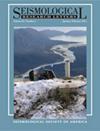Development of the Site Characterization Database for the 2022 New Zealand National Seismic Hazard Model
IF 3.2
3区 地球科学
Q2 GEOCHEMISTRY & GEOPHYSICS
引用次数: 0
Abstract
This article presents the development of the site characterization database for the 2022 New Zealand National Seismic Hazard Model update. This database summarizes the site characterization parameters at past and present GeoNet seismic monitoring network instrument locations, including strong-motion, short-period, and broadband seismometer stations. Site characterization parameters required to assess and improve empirical ground-motion models and those used in codified seismic design frameworks internationally have been included in the database. Measurement uncertainty was assigned, and the quality of the data used to assign each parameter was classified. The site period (T0) was the most well constrained of all the site parameters, with almost half of the database classified based on high-quality measurements, with these dominated by microtremor-based horizontal-to-vertical spectral ratio. Although there was an improvement in the quality of the parameters representing the time-averaged shear-wave velocity in the uppermost 30 m of the profile (VS30), little site-specific data were available, with almost no information for rock sites. Most of these classifications were based on national maps or geologic interpretation. Depth-based parameters (Z1.0 and Z2.5) had the lowest quality overall, with very few direct measurements available to constrain these values. Despite these limitations, the quality of parameters assigned to instrument locations has improved and greatly expanded previous databases through the assignment of parameter values to the entire GeoNet seismic network.为 2022 年新西兰国家地震灾害模型开发场地特征数据库
本文介绍了为 2022 年新西兰国家地震危险性模型更新开发场地特征数据库的情况。该数据库汇总了过去和现在 GeoNet 地震监测网仪器位置的场地特征参数,包括强震动、短周期和宽带地震仪台站。数据库中包括评估和改进经验地动模型所需的场地特征参数,以及国际上地震设计框架编纂所使用的场地特征参数。对测量不确定性进行了分配,并对用于分配每个参数的数据质量进行了分类。在所有场址参数中,场址周期(T0)的约束性最强,数据库中几乎有一半的参数是根据高质量的测量数据分类的,其中主要是基于微震波的水平-垂直频谱比。虽然代表剖面最上层 30 米处时间平均剪切波速度(VS30)的参数质量有所改善,但可用的特定场址数据很少,几乎没有岩石场址的信息。这些分类大多基于国家地图或地质解释。基于深度的参数(Z1.0 和 Z2.5)总体质量最低,只有极少数直接测量数据可用于限制这些数值。尽管存在这些限制,但通过为整个 GeoNet 地震网络分配参数值,分配给仪器位置的参数质量得到了提高,并大大扩展了以前的数据库。
本文章由计算机程序翻译,如有差异,请以英文原文为准。
求助全文
约1分钟内获得全文
求助全文
来源期刊

Seismological Research Letters
地学-地球化学与地球物理
CiteScore
6.60
自引率
12.10%
发文量
239
审稿时长
3 months
期刊介绍:
Information not localized
 求助内容:
求助内容: 应助结果提醒方式:
应助结果提醒方式:


